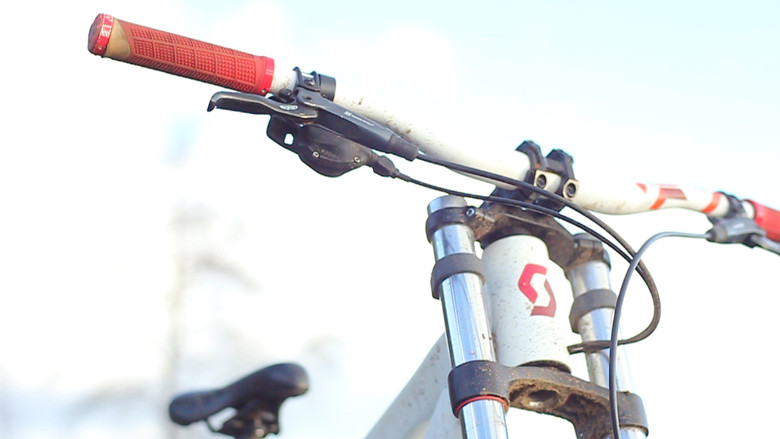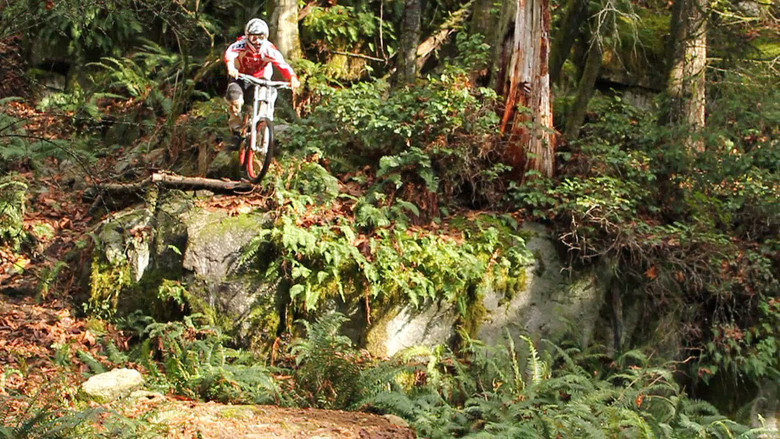by Evan Powell
Ever since the Whistler premiere of ‘From the Inside Out’ last October, I’ve been riding and evaluating the 2012 Scott Voltage FR 20.

The bike is geared toward the entry to mid-level gravity rider. Scott says it’s a freeride bike, but I don’t think they give it enough credit for its downhill capabilities. This bike would be great for any newcomer or dirt jumper who is looking to take a crack at riding big bikes, as it is easy to maneuver and has a few great geometry features. At just $2399 US, you get a whole lot of bike for a very reasonable price.
Basic Specs
- Choose from 5, 6, or 7 inches (130, 160, or 180mm) of rear travel via the Fox Vanila R shock by simply repositioning the rear shock mount.
- 8 inches (200mm) of front travel via a Rock Shox Domain R fork
- 65 degree head angle
- 13.7 inch bottom bracket height
- 135mm Interchangeable Dropout System (IDS) to accommodate several axle systems and allow for chainstay length adjustments between 415, 425, or 435mm.
- Other notable components include Avid Elixir 5S brakes, Sram X7 drivetrain, and an e.thirteen chainguide.
- Complete specs for the Scott Voltage FR 20 are available in the Vital MTB Product Guide.


First Impression
After riding it around on Vancouver’s sidewalks (we all use the “parking lot test” for the basis of our initial impressions), I was excited to take it to the trails. The stock Scott Pilot FR 1 Pro 750mm bars and Avid Elixir 5S disk brakes combine to make a comfy cockpit. After just a few minutes on the bike it was clear that it pedaled well - it didn't bob heavily while sprinting and felt surprisingly efficient considering the build. Looking down, I was impressed to see that Scott spared no expense when it came to tires. The 2.4” Schwalbe Big Betty is an excellent tire that I preferred when racing for the Yeti/Fox Support Team a few years ago. Having said all that, the bike passed the parking lot test, but how would it fare on dirt?

On the Trail
First off, I was incredibly surprised at my stupidity and the bike’s resilience to my stupidity. During the first ride, I took it on a new trail and sent a long step down kicker a good 15 feet past the intended landing. Considering the bike’s suspension hadn’t been touched whatsoever, the Rock Shox Domain R fork on the front and the Fox Racing Shox Vanilla R on the back responded well and predictably. I wasn’t bounced out of place and I continued on the trail casually. The bike undoubtedly helped save me in that scenario. I was stoked to get out of that one without my helmet full of tree bark and mud. The frame was noticeably stiff side-to-side over all trail features, including the step-down incident. The “full nelson” weld technique on the head tube area of the aluminum frame not only looks sleek, but it also provides a lot of strength to the frame, which is crucial when you’re learning to ride (or over shooting step-downs).

Prior to riding it, I found it interesting that the Coastal Crew was riding the Voltage instead of the more downhill-oriented Scott Gambler. After riding it, I understand why they would want it - the bike was so easy to pick up off of the ground that it made for a whole new airborne experience for me. As you also saw in the video, this bike is easy to throw into berms or flick around corners. I was testing a large frame and found it incredibly easy to maneuver. Considering it was a "long" size frame and the fact that I’m 5’10’’ tall, the sizing of the bike did feel a bit small. I would have felt cramped on a "short" size. Consider this when purchasing a Voltage frame or complete bike.

Because this model is spec’d with with a 200mm fork, I did not find it necessary to adjust the rear travel from the longest 180mm setting during the time I had the bike. However, the ability to adjust the travel would be key if I ever decided to put a single crown fork on the bike, which would instantly transform it into a capable enduro rig or mid-travel park bike.

The Interchangeable Dropout System (IDS) allows for a wide variety of rear wheels to be used, which is certainly a big bonus. Standard QR, MAXLE and 12mm thru-axle wheels are all compatible. It’s also easily replaceable if a derailleur hanger is bent beyond repair or broken. Chainstay length can be shortened or lengthened 10mm from the stock 425mm setting, which can help make the bike snappier or more stable at speed.


Scott packed a lot into the package, but to create a bike at this price level a few concessions have to be made. Top-of-the-line suspension is expensive, so Scott opted for the budget minded Rock Shox Domain R fork. While the fork was bomb-proof, predictable, and functioned consistently, it clunked at the bottom of its travel on a lot of the hard hits, and I couldn’t find a way around this. I doubt this affected my riding very much, but it was annoying. The stock Wellgo B155U pedals might be ok for strictly jumping the bike, but they were far too small for any gravity rider to be truly satisfied with. Having said that, I can tell you that the first thing that will need to be replaced due to wear-and-tear are the tires. The components are durable and reliable.

This bike was ridden mainly in the lower mainland around the North Shore of Vancouver. After riding it in that area, I’d be willing to say that it would function great on anything - from high-speed flowy trails, to dust and rocks, to sending jumps at the bike park.
Scott‘s investment in riders such as the Coastal Crew, Floraine Pugin, and Brendan Fairclough really shows their commitment to gravity and their confidence in their bikes. It also gives them status as major contributor to the gravity scene. To me, the Voltage FR 20 reflects a combination of their star gravity athletes - the bike is dynamic. It is responsive and maneuverable while freeriding, surprisingly stable while downhilling, and there are so many ways to tune the bike that it really can cover a huge range of rider and trail styles.

Bottom Line
The Scott Voltage FR 20 has a pretty impressive build package, is very capable over a variety of terrain, highly adjustable, downright fun to ride, and will help the budget-minded rider excel to the next level.

About the Reviewer -- Evan Powell has been riding and racing since 2006. During that time, he progressed from a 14-year-old beginner to racing in the 2010 Junior Downhill World Championships for the USA. He now races at the professional level. Evan raced under the wing of Matt Thompson in 2011 on the Colorado based SRAM Santa Cruz race team. He has experience on almost all tires and suspension types currently on the market. He is a flat pedal rider who enjoys steep terrain, long xc rides on the beach, and dirt jumping. Though he is accustomed to his native dusty trails in Colorado, today he enjoys the loamy technical riding of the Northwest, especially Vancouver’s North Shore. He currently works part time at Dunbar Cycles in Vancouver, and is a second year forest operations student at the University of British Columbia.






View replies to: Tested: Scott Voltage FR 20
Comments